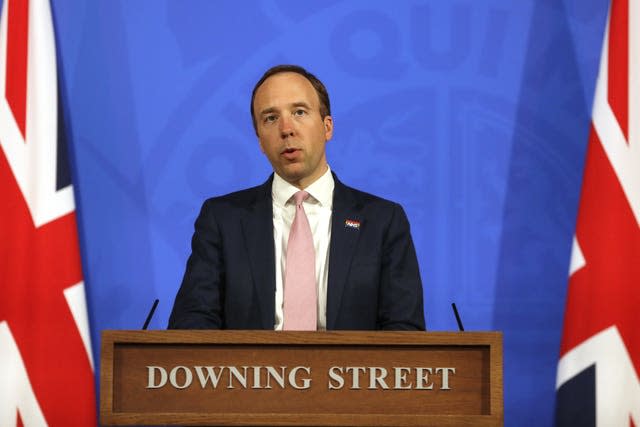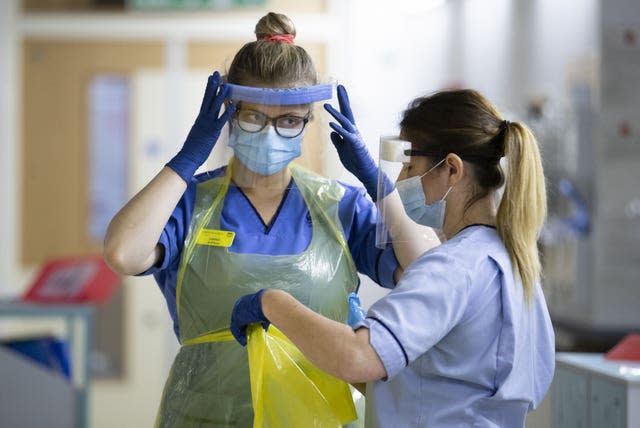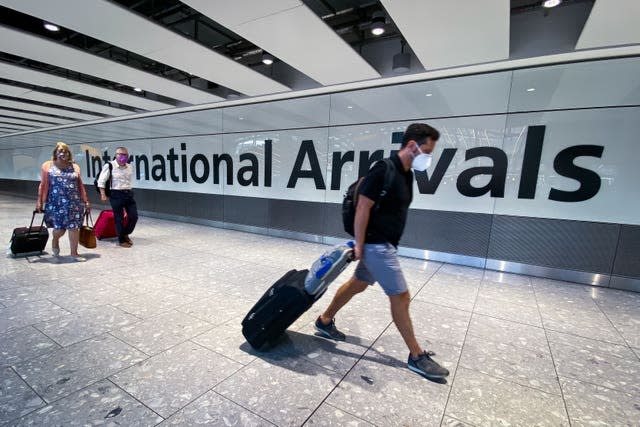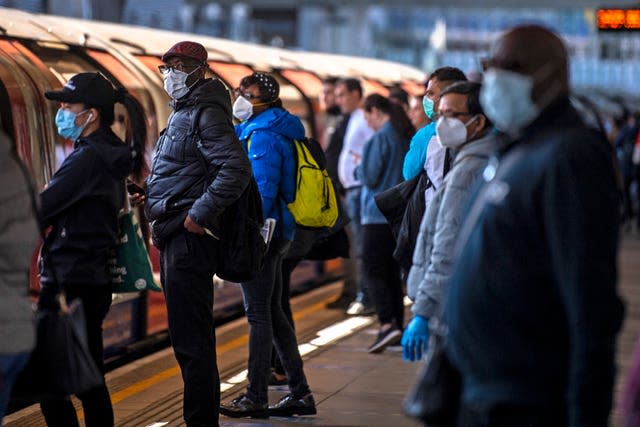What areas are likely to feature in the coronavirus public inquiry?
An independent public inquiry into the handling of the coronavirus pandemic will begin in the spring of next year, Boris Johnson has announced.
The Prime Minister told MPs the full remit of the inquiry is not yet defined but preparatory work to establish the terms of reference and the inquiry chair are due to take place before then.
However, there are clear policy areas that will face intense scrutiny going forward as the nation looks at what lessons should be learned for the future.
– Locking down
As nations across the world, including Spain and Italy, imposed lockdowns, the Government was hesitant on shutting up the UK when the virus hit last spring.
Experts on the Scientific Advisory Group for Emergencies (Sage) feared that “heavy suppression” of the virus would cause a second peak of infections and chief scientific adviser Sir Patrick Vallance said some “herd immunity” needed to be developed.
But, as understanding of just how deadly the virus was evolved, it was modelling from Professor Neil Ferguson that shocked Mr Johnson into action.

The scientist advising the Government as part of the New and Emerging Respiratory Virus Threats Advisory Group (Nervtag) predicted that merely trying to slow the spread of Covid-19, which was until then the aim, could allow deaths in Britain to exceed 250,000 and overwhelm the NHS.
The lockdown was eased in June after a plateau and decline in deaths, but cases began to rise again and on September 21 Sage recommended a circuit-breaker lockdown to last up to two weeks.
Facing opposition from Conservative MPs sceptical of lockdowns, Mr Johnson rejected Sage’s recommendation and pushed on with the tiered system of restrictions for England.
The Prime Minister has faced pressure over allegations, which surfaced last month, that he said in October he would rather see “bodies pile high” than impose a third coronavirus lockdown.
But as cases began to spiral out of control, more than a month later Mr Johnson had no choice but to impose a four-week lockdown for England lasting until December 2.
The nation was put into a new four-tier system of restrictions but another national lockdown was imposed in England on January 4, as a new highly-infectious strain emerged from Kent.
– Care homes
Health Secretary Matt Hancock said a “protective ring” was thrown around care homes, but in the initial weeks of the pandemic their residents died at an alarming rate.
Those living in care homes were particularly vulnerable to coronavirus from the off because of their age, but several factors may have left them more exposed.

Hundreds of hospital patients were discharged into care homes in England each day at the start of the pandemic, without a policy in place to test all patients before discharge.
This was later described as a “reckless” and “appalling” policy error.
Staffing is another factor thought to have played a part in the spread of Covid-19 in care homes during the first wave of the pandemic, with employees often working between different sites.
– Personal protective equipment
Frontline NHS and care home staff faced a shortage of the equipment needed to help prevent them from being infected with the virus, such as masks, aprons and gloves, during the pandemic’s first wave.
Some medics said they had no choice but to buy their own personal protective equipment (PPE) because they could not source it through traditional supply chains, due to high demand across the whole health service.
Mr Hancock faced criticism earlier this year after saying that there was “never” a national shortage of PPE, despite numerous reports from frontline staff fearing for their safety in the early stages of the pandemic.

Difficulties around sourcing equipment are likely to heavily feature when looking back over the pandemic, as well as accusations of “cronyism” in the Government’s procurement of masks, gloves and aprons.
A scathing report in November by the National Audit Office (NAO), the public spending watchdog, criticised the way normal standards of transparency had been set aside during pandemic procurement.
– Borders
Australia, New Zealand, China and other nations that heavily suppressed their death tolls included stringent border protections among their public health measures.
There was a split in the Cabinet, with Home Secretary Priti Patel having said she advocated closing the UK’s borders in March, but was apparently overruled, as the balance between public health and the economy was weighed up.
One paper considered by Sage in April said there was little justification for closing borders while case numbers were high, with imported infections representing a tiny proportion of cases.
But as the pandemic was brought under control a 14-day quarantine policy was introduced in June to guard against a second wave being triggered by outbreaks arriving from abroad.
This policy was eroded by the introduction in July of so-called travel corridors, which provided exemptions to arrivals from nations deemed safe.

Testing formed no part of the border plans until December when the test to release scheme was introduced to allow the isolation period, already cut to 10 days, to be reduced in England by a negative test after five days of isolation.
But as concerning new strains emerged in Brazil and South Africa, ministers acted to ban flights from more than a dozen countries including all of South America.
Then, on January 18, all travel corridors were ordered to close meaning nearly every arrival would need a negative test before departure and then would have to quarantine.
International Development Secretary Liz Truss defended the Government as having been “very tough” on borders but said “you cannot hermetically seal” the UK with a need for the economy to run and fresh supplies to be delivered.
– Widespread mask wearing
One health measure quickly adopted particularly in Asian countries with greater experience of tackling epidemics was the wearing of masks.
However, ministers were reluctant to advise the British public to wear coverings when the pandemic hit, partly out of concern the move would divert equipment away from health workers.
Deputy chief medical officer for England Dr Jenny Harries in March said it is “usually quite a bad idea” to recommend them to the public, warning that they can become contaminated, and there were concerns of unintended consequences.

As understanding of the virus changed so did the policy, with the advice changing on wearing masks in crowded places in mid-May.
But it was not until June 15 when masks became mandatory on public transport and July 24 when they were required in shops across England.
– Eat Out to Help Out
The first lockdown was largely over and the Government wanted a way to stimulate the economy and shore up the hospitality industry that had been ordered to close.
Chancellor Rishi Sunak introduced the Eat Out to Help Out scheme to offer half-price meals during the month of August as part of a stimulus package.
The scheme was widely popular, with businesses claiming around £840 million from the Treasury and customers buying some 160 million cut-price meals.
But some, including the Prime Minister, have suggested it could have contributed to the spread of the virus, with a University of Warwick study saying the scheme “may have substantially worsened the disease”.
Mr Sunak has said it would be too “simplistic” to connect any one scheme to a rise in cases, insisting other European nations were “following similar paths” of infections.
The Treasury said its own analysis suggests take-up of the scheme “does not correlate with incidence of Covid regionally”.
– Test and trace
The tracing of close contacts of confirmed cases was halted in mid-March as the infection rates easily raced past Public Health England’s capability.
The Government set and achieved ambitions targets to boost capability, but significant concerns remained about the effectiveness of its new Test and Trace programme.
And, as the lockdown in January struggled to contain infection rates, there were concerns that only a minority of people were obeying self-isolation rules.
Scientific advisers and Labour have called for a more comprehensive package of support, with concerns many were not isolating because of financial pressures.
But Downing Street rejected proposals to extend £500 payments to everyone who tests positive for Covid-19 in England, rather than just those who are on low incomes and are unable to work from home.

 Yahoo Finance
Yahoo Finance 